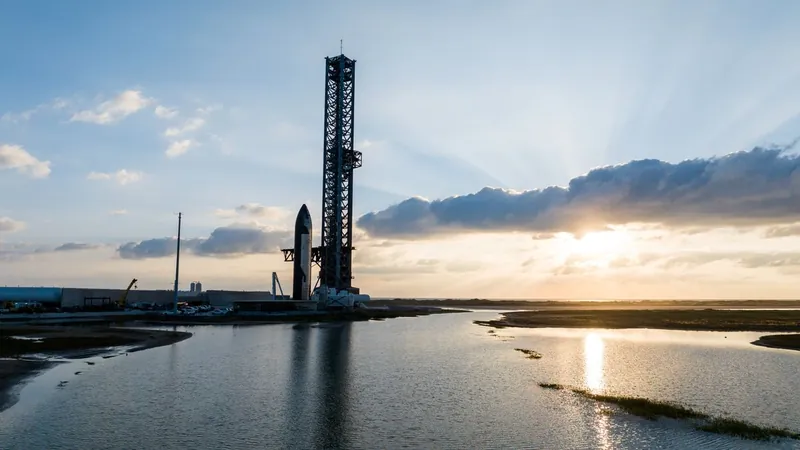
Are Humans and Mammals Facing a Distant Extinction? Shocking New Study Reveals the Dark Future of Earth
2024-11-03
Author: Emma
A groundbreaking new study warns of an impending mass extinction event, one that could rival the demise of the dinosaurs, driven primarily by extreme temperatures projected for millions of years in the future.
Led by Dr. Alexander Farnsworth, a Senior Research Associate at the University of Bristol, this research utilized advanced supercomputer climate models to predict a grim scenario that threatens the very existence of humans and mammals on Earth.
Meet Pangea Ultima: The Next Supercontinent
Researchers believe that the gradual drift of Earth's continents will eventually culminate in the formation of a gigantic landmass known as Pangea Ultima.
This new supercontinent is expected to drastically alter Earth’s climate, creating conditions that may prove to be inhospitable for most life forms.
According to the study published in Nature Geoscience, the reconfiguration of land will lead to a severely hot and arid environment.
The combination of a new continental layout, a brighter sun, and increased levels of carbon dioxide will drastically raise global temperatures.
The Triple Threat to Life on Earth
What drives these extreme heat predictions? Dr. Farnsworth describes a “triple whammy”:
1. Continentality Effect: As the continents merge into Pangea Ultima, vast land masses will be positioned further from the ocean's cooling influence.
2. Increased Solar Output: Over millions of years, the sun will shine more intensely, amplifying heating effects across the globe.
3. Enhanced Volcanic Activity: Tectonic shifts will lead to increased volcanic eruptions, releasing significant amounts of carbon dioxide and exacerbating global warming.
Dr. Farnsworth warns that this could result in temperatures soaring between 40 to 70°C (104 to 158°F) with unbearable humidity levels—conditions that mammals, including humans, may not survive.
Mammals and Heat: A Fatal Limit
While mammals have shown remarkable adaptability to climatic extremes throughout evolution, this study indicates that our upper tolerance to high temperatures remains limited.
If the Earth were to reach these projected temperatures, only a minuscule 8% to 16% of the newly formed supercontinent would remain habitable for mammals, making access to food and water a near impossible task.
Current Climate Crisis: Don’t Ignore the Present
Though this catastrophic future is millions of years away, researchers emphasize the importance of addressing the current climate crisis.
Co-author Dr. Eunice Lo warns that today's extreme heat and environmental challenges are already impacting human health.
“We must reach net-zero emissions as soon as possible to prevent an uninhabitable world for future generations,” Dr. Lo urged.
The CO₂ Reckoning and Tectonic Movements
The researchers used models of tectonic plate movements and ocean chemistry to estimate escalating carbon dioxide levels.
Current measures show CO₂ levels around 400 parts per million, but projections indicate these could exceed 600 ppm if fossil fuels continue to be consumed at the same rate.
Dr. Farnsworth points out that the predicted solar radiation increase alongside the eventual supercontinent structure could lead to dire consequences for ecosystems globally.
Implications Beyond Our Planet
Interestingly, this research not only sheds light on Earth's future but also assists scientists in the search for extraterrestrial life.
The layout of a planet's continents could affect its climate, subsequently influencing its habitability.
Lessons from Earth’s History
The study invokes the memory of past mass extinctions, which have punctuated Earth's geological timeline.
Major events, such as the Permian-Triassic and Cretaceous-Paleogene extinctions, remind us that life is far more fragile than it appears.
Sudden shifts in climate, driven by cataclysmic events like volcanic eruptions or asteroid impacts, have historically decimated vast populations across ecosystems.
In facing today’s environmental challenges, we are reminded to learn from history.
Final Thoughts
The findings from this University of Bristol study paint a sobering picture of Earth’s future, where extreme heat could threaten the survival of humans and mammals.
As we stand on the precipice of potential environmental catastrophe, we are urged to take action now, ensuring that our legacy is not one of extinction but of stewardship and resilience for generations to come.
This wide-ranging study serves as an urgent wake-up call to prioritize climate action today rather than passively awaiting a distant and daunting future.









 Brasil (PT)
Brasil (PT)
 Canada (EN)
Canada (EN)
 Chile (ES)
Chile (ES)
 España (ES)
España (ES)
 France (FR)
France (FR)
 Hong Kong (EN)
Hong Kong (EN)
 Italia (IT)
Italia (IT)
 日本 (JA)
日本 (JA)
 Magyarország (HU)
Magyarország (HU)
 Norge (NO)
Norge (NO)
 Polska (PL)
Polska (PL)
 Schweiz (DE)
Schweiz (DE)
 Singapore (EN)
Singapore (EN)
 Sverige (SV)
Sverige (SV)
 Suomi (FI)
Suomi (FI)
 Türkiye (TR)
Türkiye (TR)